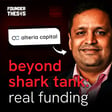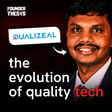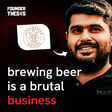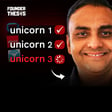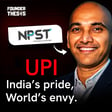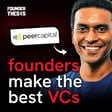Introduction and Indian Government's Financial Inclusion Mission
00:00:00
Speaker
Hi listeners, this is Ravi Gupta, CEO of Alunty Finance.
00:00:16
Speaker
The Indian government has been on the mission to improve financial inclusion for decades now, in the past, by policy changes and mandates to banks, which today is done through an ecosystem and technology approach.
Building a Fintech for 100 Million Households
00:00:27
Speaker
One of the largest financial inclusion startups in India is Avanti Finance, which is an initiative of Ratan Tata and Nanda Nilakadi. In this episode, your host, Akshay Dutt, talks to Rahul Gupta, the CEO of Avanti Finance, about building a fintech for financial inclusion for the next 100 million households.
00:00:44
Speaker
Rahul shares his learnings from his long experience inside GE and the fundamental principles of scaling up a lending business focused on the unbanked and the underbanked. Stay tuned and subscribe to the Founder Thesis Podcast on any audio streaming platform to learn about building businesses for the bottom of the pyramid.
Rahul Gupta's Early Life and Career Beginnings
00:01:08
Speaker
I grew up in small town Shimla. So I grew up there along with my mum and the two older brothers. Lost my dad when I was very young. Sadly passed away at a very young age when we was at the height of his profession. But my mother then took on the mantle of bringing up three young boys. And she did a few entrepreneurial things. So I did my bachelor's in commerce from BAV college Chandigarh. And very shortly after that, I
00:01:38
Speaker
started my career with an office automation company called Network, where I started my career selling electronic typewriters. So I was a field sales executive and spent about nine months there, good training, and then was very fortunate to be selected into
00:01:58
Speaker
Modi Xerox, which was definitely amongst the best sales organizations in India at that time. And lessons I learned there at a very early stage of my life have helped me right throughout. So at that point of time, we were selling photocopying machines.
00:02:14
Speaker
And at a very young age, I got the opportunity to get exposed to selling in retail, institutional and government sector and really understanding the different sales cycles and how to manage multiple stakeholders and deal with pressure because it was a high reward, but high pressure organization.
00:02:33
Speaker
How long was that stint? That was about two and a half years in
Joining American Express and Learning from Industry Stalwarts
00:02:37
Speaker
Delhi. I thoroughly enjoyed it. And then there was an interesting opportunity that came about in the form of American Express, which was expanding its business in India and was going to launch the Indian rupee card for one and also expand what they had was the
00:02:54
Speaker
corporate card, that time mainly the big draw was that you could use it internationally under some liberalized guidelines from the Reserve Bank. And given that they were targeting a very marquee audience, they wanted a proprietary sales team and
00:03:12
Speaker
The interview process was quite grueling, had to meet different people, but more importantly, what they had done is they had made the package very attractive at that point of time. And 30 or 40,000 people who applied for some 12 or 13 positions and those who wanted, but I think they were out of the 12 or 13 people, they hired seven of these from Modi's rock. So that also spoke about training that we all got in that organization.
00:03:37
Speaker
Did you join Amex? I joined Amex in 1992. I joined as part of the cards team based out of Bombay. Had a lot of fun meeting some industry stalwarts because I had to go and sell the card to them.
00:03:52
Speaker
directly, but more importantly, share the value proposition of the card to them.
Role at GE Capital and International Experiences
00:03:58
Speaker
G Capital had been set up in India recently and they were making a foray with very ambitious plans on the retail finance side through an organization called Countrywide at that point of time.
00:04:11
Speaker
Initially, it was a joint venture of G Capital and HDFC, and then G Capital ran it by themselves. So I was amongst the first 27 or 28 people who joined that organization, who killed a whole lot of funds. Most of what I have learned in consumer financing happened then, and subsequently in the years that, or the two decades that I served that organization, in India, Singapore, Hong Kong, and then back in Singapore.
00:04:40
Speaker
This was a credit card business that GE set up. No, actually, the credit card business came later, which was in the joint venture with the State Bank of India. But what we actually started off on the consumer financing side was financing of consumer durables. So, GE has raised a lot of its know-how in mature markets, creating white label or private label partnerships
00:05:04
Speaker
with more brands. So the end product was more like an embedded finance product, as we call it today. And the industry was very, very fragmented at that point of time. So if you were buying a color television and you wanted financing on it, it was basically whatever means the local need to have.
00:05:22
Speaker
But here we partnered with the OEMs to provide a very nationwide standard offering, which was modus operandi, which we had built across. So we did a pretty large business and then started with consumer derivatives, and then it went into different asset classes like computers and air conditions, two wheelers, cars. We were one of the two organizations which had a captive kill finance organization with Maruti, which was the leader
00:05:49
Speaker
by far, so that was an organization called Maruti Countrywide. We were amongst the largest sort of players in the industry on the consumer finance side. So I did that for about six years in different cities in India, roles of increasing responsibility. Then I took a sabbatical. I had a very interesting opportunity that gave my way to work for a telecom company, a mobile telephony company.
00:06:11
Speaker
in Eastern Europe. So I took that risk. It was my wife, myself, and our daughter who was about three years old. So we were quite excited about the chance to go overseas and
Return to India and Joining Avanti Finance
00:06:23
Speaker
live in Eastern Europe. And it was a wonderful assignment, worked with some great people.
00:06:27
Speaker
a completely different industry, different environment. And two years later, for personal reasons, we wanted to come back to India. And GE was very gracious to offer me a very good role back as the chief marketing officer and said, welcome back home. So great to be back with people at work for a long time.
00:06:45
Speaker
And then from then until I joined Avanti in 2018, I was with GE. When I came back from Eastern Europe, a couple of years in India and then a few years in Singapore, then I was running our business in Hong Kong. What kind of roles, like you were heading sales? I went to head marketing in Singapore, but then we merged sales and marketing. So I took over.
00:07:08
Speaker
Then I got promoted and went as a pretty young CEO to Hong Kong, spent a very interesting three years in Hong Kong, also navigating the global financial crisis, and then dealing with the changes that GE wanted to make to its portfolio, really winding down capital and growing its other businesses.
00:07:30
Speaker
Then I came back to Singapore, which is a business that I've helped to build. We grew it further and then we monetized it by selling it to a bank. After that, I moved into a corporate role for about six years, where I was the head of business development and strategy as a managing director for what we call GE's Global Growth Organization. So I managed
00:07:54
Speaker
the ASEAN region, which was when a few of us had joined the region was about $2 billion in annual revenues. And then as the businesses grew, we were about $5 billion in revenue. And I did that till the end of 2017, when I thought it was time to take a pause from GE who was going through its own
00:08:12
Speaker
inflection point and I thought it was the time for me to now finally look outside and then Avanti happened which was great. A lot of people blame GE's downfall on its diversification into the financial business. Would you characterize that as fair or would you disagree with
Challenges and Learnings from GE's Financial Services Crises
00:08:30
Speaker
that? See what happened was unfortunate and clearly part of it was GE's own doing.
00:08:35
Speaker
So I think there were a couple of reasons in my opinion. In the financial services business, I think for wholesale business, that proved to be a big issue, especially which got exacerbated by the fact that the GFC happened.
00:08:50
Speaker
Okay. You'll need to break this down for outsiders. What do you mean by wholesale finance? Really, GE was a non-banking finance company. So it wasn't a bank. And at one point in time, it was the largest non-banking finance company in the world with a balance sheet of 800 billion of assets and larger than many banks as well.
00:09:12
Speaker
And when you're really relying on wholesale funding and not retail deposits, as banks have, that is what caused the challenge, especially as I mentioned, catalyzed by what happened with the external environment. Personally, for me, there were some amazing experiences there. One was managing through the crisis. And you only do these things when you have a great team with you. And GE always has great people.
00:09:37
Speaker
Well, not only competent, but it had a culture of having each other's back. And then monetizing a few businesses for GE by selling those businesses with the intent that the businesses that we have built, the strong franchises that we had created, finds a good home for the people and what one had created for your end users and our customer segment. And which then after we sold off the Singapore business, which I was running,
00:10:03
Speaker
I got an opportunity to move into the global growth organization role as the business development and head for online industrial business in Farzia region. And that was amazing because it was only because of the support that one had and what I've done in G that I got that role. I didn't know much about industrial business. But that was fascinating because there was a very steep learning curve, but I really enjoyed it because in the first 15 years I was very focused on
00:10:33
Speaker
the financial part of our business, which I was part of. And then I got to learn a lot about our other businesses such as healthcare, power, aviation, oil and gas, all of which were extremely fascinating. Who bought these India business on the capital side? So we asked that question on credit cards. The credit card was actually
00:10:54
Speaker
So it went to SBI and then you have that business has some institutional investors such as Carlyle, et cetera. So that was the core care start business. And then we had some parts of the consumer finance business was then sold to Apollo along with the senior leaders from which at that entity today is currently known as clicks capital.
Avanti Finance's Mission and Innovative Model
00:11:19
Speaker
So, Avanti Journey, March 2018, I was in India for two reasons. One, to spend quality time with friends and family since I had left GE end of December and I was figuring out and exploring my next gig.
00:11:35
Speaker
And where were you based out of? I was based out of Singapore. And in all probability, I was going to land up doing something in private equity. I used that time also to suss out the scene in India because I always wanted, I'd been in Singapore at that time for about 14 years. I'd been overseas for about maybe 17 years or something.
00:11:54
Speaker
And for me, it was coming back to India was always the path, but it was never a question of if it was always a question of when. And while I was here, I was meeting different people. I was quite amazed at the progress that India had made, especially on what it was doing on the strength tech side, the technology side.
00:12:12
Speaker
and how far it had gone. And during that time, I caught up with a very leading search firm, which spoke to me about Avanti and said a couple of luminaries like Mr. Tata and Nanda Milikani are getting together to solve for financial inclusion at population scale. Would you be interested? And I said, listen, it sounds very fascinating, but obviously I'd like to learn more about it.
00:12:38
Speaker
And that led to a series of conversations with the founders and other board members. And at each stage, I got more and more convinced that this is what I wanted to do. So the process took its own time in terms of meeting different folks and for me to deliberate and for them to get together.
00:12:57
Speaker
But at each stage, it was a better conversation than the last one where my clarity in terms of what division was became better and better. And I was quite convinced that should I get this opportunity, I would consider it a privilege and I would take it. So that happened. And then I moved here by myself in early October, 2018. So it's a little over four years.
00:13:27
Speaker
No, it was beyond an idea. So the NBFC and NBFC MFI license that we had had happened, the design of Avanti, the vision mission had been spelt out and a core team of about four or five people had been assembled by the board. So I was fortunate that a lot of that had happened when I came. So I got
00:13:53
Speaker
So I came into a leadership team which was very capable and it's the same leadership team till today and very mission aligned. And the vision and mission had been clearly stated, but it was absolute kind of other way startup phase and they were just a bunch of us. And yeah, it's been an amazing journey since then.
00:14:15
Speaker
What was the gap that Avanti wanted to fix? Avanti wants to fix enough of a hundred million households, which are either unserved totally or underserved by formal financial services. And which basically means that four or 500 million people in India are excluded from the formal financial system. And that creates a big issue that
00:14:41
Speaker
these people never get an appropriate opportunity to usher in economic prosperity into their lives. Financial services here is credit or other things also, like? Credit has been our first intervention. It is one of those things because everybody at the base of the pyramid, the small ticket loans or income generation loans,
00:15:05
Speaker
that has to be fulfilled first. But our goal is not to be a mono product company, but also we want to build scale and we want to become good at what we're doing. But the idea is once we do that in our playbook, we will do other forms of products such as partner with others to have fit for purpose, insurance products, savings products, really in the spirit of being a new bank for the hundred and underserved population of the country.
00:15:33
Speaker
India already has the microfinance institute ecosystem which serves say a population outside of like beyond the SECAB category population. What was the gap? Why were these people not served? Let's take a step back.
00:15:50
Speaker
microfinance institutions since about 2010 and so the last 10, 12 years have done a fabulous job of going to the last mile customers, which earlier the banks and other financial institutions had not been able to do. But despite all of that, there are still a hundred million households which are unserved or underserved. So when that was the problem statement,
00:16:13
Speaker
And when our founders got together, it was fairly evident to them that this gap has to be solved by a very reimagined model, which is going to be very agile, adopting and integrating with all the new technologies of India stack and India digital public infrastructure that has been created, which is leading the world really. We're not following anyone there. We are leading the way there.
00:16:42
Speaker
It was with an audacious vision like that, it was always very clear that you can't be a proprietary balance sheet lender. So you have to get multiple pools of capital to come from different forms of financial institution, which will fuel the credit output to the target segment. And lastly, to be frictionless and scalable, you had to solve for the conundrum of doing this digitally.
00:17:08
Speaker
But to a population which may not be relatively savvy. And that's what we try to solve for every day. And we have some very interesting use cases around it. And that to reiterate, that's why it's a platform. And it's not just another business where you create brick and mortar as your way of reaching customers.
00:17:28
Speaker
Then you employ lots of people in the branches and around that to lend and collect and administer. And then your scalability also is largely dependent on how much money you can raise on your balance sheet. So here, the idea was start with your own balance sheet to build a proof of concept. After that, try and unlock all the capital that is available to go to either priority sector lending or the last mile customers and channel it through
00:17:56
Speaker
Avanti's role as a program manager, which can leverage community organizations to source, design, write products for our customers, and aggregate capital across different financial institutions. So on one side, you're reaching the customers, you're solving for them for purpose products through a channel, which is not brick and mortar, but
00:18:23
Speaker
Other organizations, which are the ad tech players or players with whom we have embedded finance programs or other MFIs, et cetera, who may not have the capital needed to build scalable programs would definitely have the local knowledge and connect with customers to do so. And then you have capital providers on one side, such as a large banks and other financial institutions where that money flows through our digital spine. So very different reimagined one.
00:18:53
Speaker
There must be a reason why this 100 million population has been unserved. For example, not enough data to underwrite
Underwriting and Developing Financial Products for Unserved
00:19:00
Speaker
them. The axiom in the lending industry is that it's easy to give money, it's hard to take it back, like collecting through the challenges and collecting money from this 100 million household audience. So what was the way that you thought about these problems and how you would solve them?
00:19:16
Speaker
Let's look at it from a customer point of view. Why are they unserved or underserved? One actually said is the envisage risk around them, that they are data dark. So how do you underwrite that? So if you look at our customer base, about 30% of our customers are absolutely new to credit, which means the first time they have ever borrowed from a formal financial organization as Avanti. So what does that do? It helps them build a digital financial footprint. And if they build
00:19:44
Speaker
By virtue of this, if they build a good financial score, it's going to empower them in the future and open up more avenues for them to borrow for their needs. But how do we underwrite them, right? If they're not part of any formal bureau scores, et cetera. Now, which is where these local partnerships that we have, where these trusts are originating partners are very well entrenched into the community. They give us what we call a social trust signals, saying,
00:20:13
Speaker
Your loan, let's say you're giving up 50,000 rupees loan to this person is going to be used for this income generating activity. So disposable income will grow significantly, hopefully after they pay you as well.
00:20:30
Speaker
So one, it's going to have an impact. And because you're helping them generate more income and live better, their motivation to repay you is also that much higher. So it's actually a big risk mitigate. But to do this actually, you need risk capital. These are hypothesis things that we have.
00:20:47
Speaker
And that's where we put the risk capital to clear to say, okay, let's go and test it. And we are very happy that it's working very well. And people at the base of the pyramid have very honorable intentions to always pay you back. Challenge sometimes is that they always end up taking some knocks on the other in their livelihoods. So you have to be patient enough to understand that delayed payments does not mean write-offs.
00:21:12
Speaker
So, if people are delayed sometime because their livelihoods have generally suffered, as was evident during COVID, then just have that patience to ride the storm with them because largely what we see in this segment is at a consumer level, there are very few bad actors.
00:21:28
Speaker
So one is how do you underwrite customers who are data dark using social plus signals and leveraging the power of existing communities, which is why we decided to go through this partnership model rather than establish our own brick and mortar. So that's one difference.
00:21:46
Speaker
The second difference is building products which are fit for purpose. Now, if you give a farmer a loan and they are going to monetize their crop, let's say every three months, but you ask the farmer to repay every week, it doesn't make sense. Now, how do you build products where the repayments are also linked to the income streams?
00:22:06
Speaker
And we've built a very agile platform which allows for repayments or moratoriums, literally according to what the customers want. So the customers want to repay daily, weekly, fortnightly, monthly, quarterly, budget payments. We built for all of that.
00:22:25
Speaker
If a customer is in the business of, let's say, dairy, and they take a loan for cattle, but the yield is only going to happen in three months later, and therefore they need a monotone for the first three months, then that is something that we build the technology layers and ability to do that as well.
00:22:45
Speaker
So that's really solving for customers taking into account the hyper-local nuances of product development because sitting in Bangalore or Bombay, we're not going to know what people in different parts of India and remote parts of India. The third is
00:23:01
Speaker
the constant capital that you need. And which is why for us, we've not restricted ourselves just by being a balance sheet lender. We've done that to prove a concept to show our skin in the game. But going forward, we'll end off on a balance sheet. We'll do co-lending with other financial institutions. And we already have some other use cases where there is some very purpose
00:23:23
Speaker
led lending that we have done during COVID, etc., where global foundations have given us subsidized debt to tailor programs to help rehabilitate people whose livelihoods suffered during the pandemic. And let me just zoom into all three of these. So your first point was that you go to market with partners instead of building your own distribution.
00:23:46
Speaker
So this was there from day one, you wanted to go through partners. Yeah. We have three operating principles that we should be paperless, presents less and cashless. And I'll expound on each one of them. Paperless means that all the information should be captured on an Avanti app, which is filled out by a partner's agents on the ground. So it's an assisted mode because our end user may not even have a smartphone.
00:24:11
Speaker
So, they're insisted in filling the details, but all the validations, verifications, information capture is all done paperless, it's all done on the app. The second leg is the presence less part, where we don't have a single branch. So today, we are operating in 22 states and 250 districts of India, which is roughly a third of India's districts, without a single branch of ours.
00:24:38
Speaker
And our whole logic or thought process behind it was you already have existing players or emerging players who are totally intertwined with our customer segment. So we have to move that ability to reach our customers.
00:24:55
Speaker
And last is our North Star, which is cashless. That's a tough one. So from an ecosystem perspective, India is evolving rapidly.
Digital Transition and Efficiency Goals
00:25:05
Speaker
From giving our customers the tools to repay digitally, integration with banks, the different payment gateways, etc.
00:25:12
Speaker
We have done all of that, but there are social challenges of people being comfortable paying digitally or saving them. So that's a small percentage of the overall repayments that we get, but we feel that's rapidly going to change in the next few years. And that will be a game changer because imagine a world where 100% of our customers are paying digitally. So the cost of collections comes down, the velocity of cash comes down, which reduces cost of credit.
00:25:38
Speaker
less instances of fraud, et cetera. So the customer will be the biggest beneficiary in terms of the reduced rates and higher impact. Who are the partners that you went to market with? Give me some examples. And what are the kind of people that you're lending to? What's your target demographic? So let me answer the second part first. So about 90% of borrowers are women. Of course, they may be taking a loan for a purpose which
00:26:07
Speaker
they are jointly doing some form of income generation with their spouses. Almost about 50% or so of our customers are smallholder farmers. Then you have other forms of customers who are in some form of agri or agri allied activities. Could be dairy, poultry, piggery, go tree, et cetera.
00:26:28
Speaker
And then there would be about 25, 30% of our customers who are really the micro MSMs with small shops, vegetable vendors, so and so forth, where they want to loan really is basic work in capital for them. The kind of partners we have other financial institutions, such as the smaller MFIs, et cetera, which understand the basic principles of lending and connecting and customer service may have
00:26:54
Speaker
very deep-rooted relationships with their customer base, but don't have big balance sheets to lend. So they become business correspondents of ours. There are ag tech players where we are building out some very interesting embedded finance programs. So on the first category of players, we have organizations such as Samita in Madhya Pradesh. On the ag tech side, we have, or on the embedded finance side, we have people like Estelle Apps.
00:27:23
Speaker
And we have a bunch of farmer producer organizations or collectives to whom we lend either directly to them or through them to the end farmers. And there's one more category, which is what we call as social partners, which could be not for profit organizations for whom financial inclusion is part of their charter, such as organizations like Seva. And all put together, these are the ones which have given us a fairly robust nationwide presence, as I mentioned, in about 22 states.
00:27:52
Speaker
Is there an incentive for them? Do they also earn when you disburse funds? And do you disburse funds to a group like an MFI or is it to individuals? Yeah. So we disburse directly to the individuals. So our belief is that as the identity layer has got established in India, as everybody has a bank account, that need of creating these joint lending groups is going to become lesser and lesser.
00:28:19
Speaker
So looking at the building a sort of future driven model, we then directly individuals, of course, may do some activities in a group kind of construct just for productivity purposes, which is getting people together to onboard them or connect from them, et cetera. So that's
00:28:37
Speaker
a little bit on who do we lend to. You had, there was another question, another part of the question actually. Incentive. Yeah. So the incentive is different form, the ranges and forms of incentive. So if you look at, for example, another MFI partner, the
00:28:52
Speaker
The incentives would be sharing of the percentage of the interest we get because they have their own cost of people, branches, et cetera. So they need to cover the cost and make some profit on that. So that will determine the percentage of speed share.
00:29:07
Speaker
If some of the embedded finance products, what we pay them might be just enough to cover their cost because the Avanti finance is allowing them to sell their own product. The embedded finance means like a BNPL buy now, pay later, which helps up to use the sales? Yeah, BNPL is more of a sort of direct to consumer product. In our case, it could be if there is an ad tech player, which is picking up
00:29:34
Speaker
produce from farmers and aggregating it to, let's say, sell it to the big grocery stores in a metro. Now, in order to have that high velocity cycles of pick up, produce, pay the farmers, pick up, and repeat, that's where Avanti comes on in terms of providing that short-term working capital because that's not the core business of, let's say, the hectic plant.
00:29:57
Speaker
That's just one example. And there are many other session cases. And then in the social partner category, what we say a lot of them have been doing in partnership with other organizations, providing loans for people for income generation. That's what we do for them. Again, it's more a question of capturing, making sure that the costs are covered, less about it being a profit driver. So there are different sort of ranges and motivations of incentives.
00:30:26
Speaker
Okay, got it. What is your NPA rate? So our rate is sub 2%, which is well below what we target. That's amazing. I think very few lending architects have a sub 2% NPA rate. Help me understand the business model here. What is your cost of money? What is the interest rate that you earn from that? And from that, what is your the overheads and what is the margin that you're left with?
00:30:53
Speaker
Yeah. So let me give you, let me paint pricing waterfall for you here. So let's just look at the different levels. So firstly is our cost of capital. So our cost of capital typically will be you get solely look at our borrowings will be in the 12 to 13% range as an early start as early stage company with triple B plus rated, but we've been punching above our weight here and getting funds at almost double a minus sort of rates.
00:31:21
Speaker
But then you have to add on the cost of losses, the cost of operations. For us, the big investment we're making upfront is technology. Now, platforms typically, the investment in technology upfront from the beginning is a little disproportionate to the size of your business. But that is the biggest edge as you move forward because
00:31:41
Speaker
or once your platform mature and the productivity comes in, your transaction costs can start trending to very small numbers. So that's the patient capital and the strategic capital you need to put in. So we have cost of capital, we have cost of investment, largely in technology. You have to budget for losses, you have to budget for operation costs, and then you have to budget for the payouts that you give to your partners.
00:32:04
Speaker
And these payouts can be quite different. So depending on who is your sourcing partner, as I explained earlier, the difference most people have, that determines how you pay out. And depending on that, you will determine your final lending rate to the end borrower as well, depending on which channel it was sourced.
00:32:23
Speaker
The rate would differ based on who's sourcing the deal for you. That cost will get passed on to the borrowers. Correct. When it's with MFI, which has costs attributed to real estate, people, et cetera, then you have to cover that cost. If it is an embedded finance, the motivations are different. So that's how it works.
00:32:41
Speaker
But what is the average rate at which you lend out? Rates could be anything between the retail level, could be anything between 19% to 24%, which is technically in line with what the industry in India is doing, largely because the cost of capital itself is 20%.
00:33:01
Speaker
So could you give me like a journey year by year? 2018, once you started, like a year by year breakdown to where you are now, like what was your year one go to market and how many funds, like how many loans did you give out or what was the dispersal and something like that, if you could take
Preparation for Series A Funding and Pandemic Growth
00:33:18
Speaker
me through. I may not remember exact numbers year by year, but I'll definitely share the journey with you.
00:33:25
Speaker
2018 was the year where we went to market to test out a proof of concept in terms of building out a digital delivery model for the base of the pyramid. So, we spent 2018 bringing the technology into the field and we had relationships with about three or four partners across five or six states.
00:33:48
Speaker
And we spent that year really understanding, and this is more, most of it happened actually in the last four or five months of the year. And we spent our time understanding the implementation of our technology in assisted mode by our partners. So firstly, how comfortable the partners were. The adoption of technology in an assisted mode by our customers.
00:34:13
Speaker
And a lot of time in terms of insights gained from commerce and partners has to what's working and what the gaps are. And we started building our team. By early 2019, we were beginning to grow quite well. What kind of monthly disbursement? Yeah. So we were at that point of time beginning to do at least a few corrodes a month, but
00:34:36
Speaker
with an opportunity to leapfrog that by three times, four times, very quickly. And then what happened is that in, as we were growing, so we were seed funded and then we started saying, okay, the first one by Mr Tata and Mr Nail Kani. Yeah. So we were seed funded by Mr Tata and Mr Nail Kani. And then 2000 and
00:34:57
Speaker
19 is the first year we went and took an external loan for on lending. And then we said, okay, we're getting a lot of confidence in terms of our business model. And maybe we should start looking at a Series A and what would it take to do a Series A.
00:35:14
Speaker
And so we spoke to a lot of potential investors in terms of our business model, why we were confident about it, yet it was untested and we were in very nascent stage. And there wasn't much to show in terms of proof points, except some early successful pilots.
00:35:32
Speaker
And as we were sort of, you know, with the debt that we had, et cetera, as we started growing, and then COVID happened. So we are in many ways a COVID baby. And that's the point. That's the time in 2020, which was a difficult year, where they were new revenues were not being generated because our series, they had got stored and the money and anyway, there was a moratorium on repayments. So money is not coming back. New monies are not flowing out. So we went through that. But
00:36:00
Speaker
Our founders were very clear that use this time to come out stronger. Be very sensitive to your borrowers. Understand the pain that they're going through. Learn from the stress test and whatever investment that we need to make, make it in a manner where we learn from what's happening in COVID.
00:36:20
Speaker
Hopefully not something as severe, but in the base of the pyramid, there are always some instances that happen that knock the wind out of people's sails. So how would you learn to manage your risk and your customer empathy? How do you balance all of this out as you create a platform? So we kept chugging along and we kept investing in our technology through the support of our founders because they had strong belief in what we were doing.
00:36:45
Speaker
And that actually then led to a very eventful year in 2021, where we raised a Series A through some very mission-aligned investors, such as Bill and Melinda Gates Foundation, Oico Credit, which is a Netherlands-based large impact investment organization, and the Murabank, and also some private capital that came from
00:37:10
Speaker
a gentleman in Gujarat who's a technopreneur philanthropist, in addition to some repeat funding that was provided to us by our founders. Now that allowed us to grow and we grew about three and a half times to a book of about 350 crores or so by the end of March 2022.
Expansion Plans and Leveraging Partnerships
00:37:30
Speaker
Our ambitions now are quite big. And we are now at a phase where we're looking at getting into breakout growth phase. So having served 200,000 customers for different livelihoods, different use cases across the country, we are now looking at really accelerating and getting to
00:37:52
Speaker
about an AUM of about 2000 crores, about half a million customers or more served in the next 18 months. This will happen via a few key drivers. One is that the last leg of our platform strategy is coming to life now, where we will embark upon co-lending with some very reputable institutions.
00:38:16
Speaker
which gives us the access to additional capital to server last mile customers and gives the ability to reach cohorts that they can't reach themselves and leverage on the technology we build, the partnership network we've created across the country and the risk management ability that we have internally.
00:38:38
Speaker
Plus, there is a lot of demand that we have curated. And we have been working very closely with all the partners that we have. So together, we will now get into a very exciting growth phase for the company. And it's not just growth phase for the company. Every day we come to work, the more customers we serve, it means the more impact we're making in the lives of people we were meant to. So that is what gets us out of bed every morning.
00:39:05
Speaker
Amazing. What's your current monthly disperson? So let's just say that we are now running at a range of about 60, 70 crores targeting to get to 100 and then the logical step to go from 100 to 200 crores over the next four to six months.
00:39:21
Speaker
Like by middle of next year, you'd be dispersing about 200 crores a month. I would hope so. Wow. Amazing. Okay. So co-lending that you're speaking of, is this where there's this priority lending requirement? So is it for that helping banks and other organizations to meet that priority lending targets? I think banks get a couple of advantages. One is the PSL targets.
00:39:44
Speaker
Two is other than that, they also get access to customers early in their banking cycles. So a lot of these customers, we sort of upgrade that the banks can offer them products for the different life cycle of their needs, but banks can't put branches everywhere. They may not necessarily understand the economics of making money on a 30,000, 40,000 rupee loan, along with the cost of credit, which has to be managed. So given that we have now invested
00:40:14
Speaker
time and capital on that. We have a very credible story to partner with. And that is what is drawing the great attention of reputed institutions to work with us. Okay. So the fact that your go-to-market is through partner agencies would keep your operation cost pretty low. Absolutely. Now, just to add to that, so at the amount of business we're dispersing currently or will disperse, let's say even at, we're about 60 people in an organization.
00:40:40
Speaker
Right? So let's say when we start very shortly, when we start dispersing 100 crores a month, which could be in a month or two, we'll still be 60, 65 billion. Now, typically companies in this segment that we are talking about, I'm not talking about urban segment, if you're going to be doing 25,000 loans a month, you have typical brick and mortar, financial institutions, MFIs, et cetera. They may even have a thousand people and hundreds of branches to do this, but
00:41:09
Speaker
We are extremely late. So there's a huge difference there. Do you also attract ESG money? There is this global theme of environment, social governance, and so like that ESG funds for as cool ending partners. You bring about a very valid point. And in fact, I've just come back from a business trip in Europe where there was big talk about ESG and ag refinance to combat climate risk, gender, various elements of ESG and SDGs.
00:41:38
Speaker
Clearly, what's happening is if I was to not just straight jacketing in PSG, but there's an impact, hopefully will become more mainstream. It's not there yet, but there seem to be some moves which
00:41:53
Speaker
definitely will all go well for the industry and the customers that we're trying to serve. So some of these themes that I spoke to you, there was big discussion around it. And everybody's looking at how are you imbibing that in your business practices as part of your strategy. And do you have a roadmap for it? So I think we're at an early stage of that big ESG roadmap, but we clearly are building towards it because this is reality and we have to play a part.
00:42:18
Speaker
What's your leverage ratio? What percentage of your assets under management is equity? Like how much is that debt to equity?
Vision of Becoming a Digital New Bank for the Underserved
00:42:25
Speaker
So we have a debt to equity currently of about approximately about 2.5 times. So there is still room to leverage more. And with co-lending coming in, what could be the like the ceiling of this number that you could hit? Like by the time you hit your 2000s year target? Actually, I won't say it'll actually come down.
00:42:46
Speaker
because if you look at a co-lending model, then if you're doing 80-20, only 20 is on your balance sheet, 80 is off your balance sheet, right? So you're actually leveraging much more and then your need for capital comes down. So it becomes a very capital efficient model.
00:43:02
Speaker
Your leverages will actually come down. You might be lending as much as 10 times your equity if you include the total amount left, not just your balance sheet. Our goal is that at mature stage, maybe in two, two and a half years' time,
00:43:18
Speaker
or at increased mature stage, almost 60 to 70% of the lending we do or the AUM we have will be off our balance sheet. What is the five-year roadmap for Avanti? I think in five years' time, I would say hopefully we would have
00:43:34
Speaker
Witness the WhatsApp moment of our business where this whole concept of a digital delivery model to the base of the pyramid being executed in a paperless, presentsless, cashless model would have become quite mature. I would hope by then in five years' time, we would have served at least 20, 30 million customers or more and played a meaningful part in the journey of enabling access to formal financial services to
00:44:04
Speaker
the 100 million who are out of it. Because we don't want to do all of this, right? The reason we're creating a platform is other people in the industry can leverage our platform to do. A big part of us is to be an ecosystem enabler. We hope that by the intervention that we would have debtized credit to a large extent. And we would have also helped people in their overall financial well-being, not just through credit, but through other fee-based products and liability products such as
00:44:32
Speaker
savings, insurance, et cetera, because all of those are important to create financial empowerment and financial equity. Hopefully we would have very clear metrics on the impact that our financial products would have made in the wellbeing of our customers. And we should be some form of a digital new bank, which is serving swaths of the population, which have been hitherto excluded.
00:44:59
Speaker
Tell me about building up Awati as an organization. Like you are an extremely lean team of just 60 people. So I'm pretty sure that these would have been like highly handpicked, highly mission-driven individuals. Tell me about that journey. So actually firstly, I think let's start with the co-founding piece. So as I mentioned, the board had handpicked few very capable folks.
00:45:24
Speaker
who was the original co-founding team of Avanti, who are still there. And in fact, our coast towards of the organization, I was fortunate to become part of that team. So we have my colleague Manish Thakkar, who's an ex-investment banker, Lalitesh, who's a global technologist, co-founder of Google in India, the person who built Google map maker on which Google maps as we know today was built, Sunil, who has done
00:45:54
Speaker
very senior roles in consulting, the last of which was with Accenture. And more recently, we had a very, very capable and mission-driven individual, Nagra, who joined us as a Chief Risk Officer. So it's really the leadership team. And then we have, of course,
00:46:11
Speaker
many more folks in the organization. So I think the leadership team manages the company collectively. Each one of us brings something to the table, and then it's a question of always some of the parts. So yes, we've been very fortunate to build a very high energy performance-oriented mission-driven team, very young, but very mature in their thinking and in their clarity as to why they want to be part of how one feels for it.
00:46:38
Speaker
And that brings us to the end of this conversation. I want to ask you for a favor now. Did you like listening to this show? I'd love to hear your feedback about it. Do you have your own startup ideas? I'd love to hear them. Do you have questions for any of the guests that you heard about in this show? I'd love to get your questions and pass them on to the guests. Write to me at adatthepodium.in. That's adatthepodium.in.













